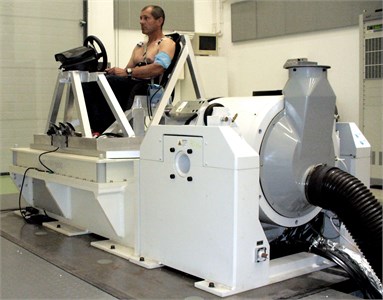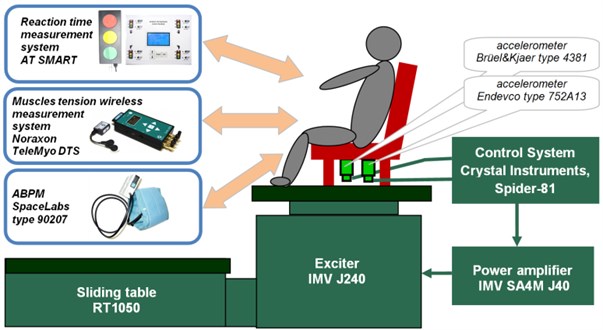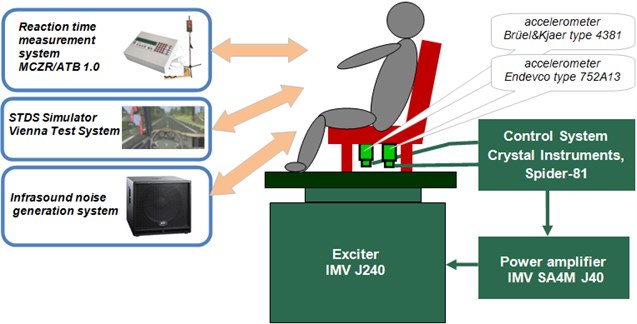Abstract
This paper presents examples of using ways of test bench for whole-body vibration simulation in scientific research. Developed test stand allows to simulate the vertical and horizontal vibration. It is based on vibration exciter made by IMV and a developed test seat, which ensures during the test the correct position of the subject of 160-190 cm height and up to 180 kg weight. Presented applications of the test bench include vibration impact studies on muscular tension, circulatory system and complex reaction time as well as studies on simultaneous impact of infrasound and vibration on psychomotor functions of the employee.
1. Introduction
Mechanical vibration is one of the harmful factors in the work and life environment. Exposure to mechanical vibration can impact negatively on both the physiological and psychomotor functions of human. Previous studies have shown, among others, that the appearance of musculoskeletal disorders caused by mechanical vibration can cause permanent lesions [1-3]. Exposure to whole-body vibration can either cause changes of heart rate. The parameter values of the EMG signal depend on a variety factors, among other on the exposure to mechanical vibrations. Psychomotor disorders often lead to lower efficiency, which also increase the likelihood of an accident [4, 5].
The study of phenomena related to the effects of vibration on the employee is particularly important from the point of view of the safety and health protection. In Central Institute for Labour Protection-National Research Institute in Warsaw the test lab to simulate whole-body vibration was built. Developed test bench allows to use it in the studies on the vibrations impact on human body as well as on mechanical systems in many aspects.
2. Test bench
The main part of the bench is the system for vibrations generation based on exciter IMV type J240, power amplifier IMV type SA4M J40 and control system Crystal Instruments Spider-81. The system allows to simulate both horizontal and vertical vibration in frequency range 1 Hz to 2200 Hz with rated force up to 24 kN, maximal acceleration 923 m/s2, maximal load 400 kg and maximal displacement peak-to-peak 100 mm. The system has static load compensation and positioning using a pneumatic system. For control generated vibration signal multi-channel feedback loop is used. It allows to the continuing work of the system even in the event of a failure of one of the control sensor or unforeseen disruption in one of the channels. This increases the accuracy of the maintain of vibration exposure simulation parameters and minimizes the likelihood of work interrupting of the vibration generation system when carried out tests.
In order to carry out research of vibration impact on the human body, the test seat has been developed (Fig. 1). It ensures the correct sitting position of the subject of 160-190 cm height and up to 180 kg weight. The developed bench provides simulation vibration signal without disturbances in the entire range: 1 Hz to 90 Hz used in the research (resonance frequencies of test seat elements > 120 Hz).
Simulation of the horizontal vibration is carried out using the sliding table RT 1050. Aluminium cage construction of test seat mounting system allows to install driver's equipment (steering wheel, pedals, etc.). Simulation of the vertical vibration requires retooling the exciter equipment. In this configuration the test seat is mounted through aluminium measuring table TBV1000 weighing 146 kg. The table is fixed to the shaker’s headexpander using four vertical guide bushings, moving in the longitudinal ball bearings attached to the shaker’s body and an intermediary plate with dimensions: 1000 mm×1000 mm×18 mm. The plate was made of magnesium alloy AZ91 (GA8) in order to ensure low weight (26.4 kg), high strength and stiffness.
The test bench is located in an air-conditioned laboratory so that it is possible to maintain accurately the desired ambient temperature during the tests.
Fig. 1Test bench for whole-body vibration simulation

3. Applications of the test bench for studies on vibration impact on muscular tension, circulatory system and complex reaction time
One of the test bench applications was to use it in studies on low-frequency whole-body vibration impact on some physiological and psychomotor functions of the employee. In the studies as vibration test signal filtered white noise with frequency range: 1 Hz to 30 Hz (controlled with an accuracy of +/–2 dB) was used. A single exposure to the subject lasted 20 min. The value of the frequency weighted vibration acceleration of the test signal was 0.9 m/s2 and it was controlled with a precision of +/–0.05 m/s2. In Poland it is 28 % of the limit value for short-term exposure whole-body vibration in the working environment of 3.2 m/s2 [6].
Experimental tests were performed during (and after) simulation of vertical (first test series) and horizontal (second test series) low frequency whole body vibration. Their scope includes:
• selected muscles tension study (EMG – electromyography),
• cardiovascular parameters study (heart rate, blood pressure),
• study of the impact of vibration exposure on psychomotor functions and cognitive processes (complex reaction time test, attention and perceptiveness test).
Diagram of the test bench prepared for the tests is presented in Fig. 2.
EMG study of selected muscles was performed using a wireless system TeleMyo DTS by Noraxon. The signals from selected groups of muscles were recorded continuously throughout the duration of the study. The results of the research were obtained in the form of EMG time runs recorded before and during exposure to low-frequency vibrations as well as during the test MVC.
Ambulatory Blood Pressure Measurement were carried out using SpaceLabs type 90207. Blood pressure and heart rate were measured in a sitting position before, during and immediately after the exposure to vibrations.
The tests of psychomotor functions and cognitive processes due to exposure to low-frequency whole-body vibration were carried out using a reaction time meter (with equipment) by AT SMART. The aim of the study was to evaluate the speed and uniformity of response to the tone and visual signals in the complex task. The study was performed in three series of measurement: before exposure to vibration, during the vibration exposure (after 10 minutes from the start of the exposure) and after completion of the exposure to vibration.
All the tests were conducted at controlled ambient temperature in the range: 21-23 °C and a relative humidity of less than 70 %. Objective, scope and methodology of the study have been approved by the Commission of ethics and bioethics, Cardinal Stefan Wyszyński University in Warsaw.
Fig. 2Diagram of test bench prepared for studies on low-frequency whole-body vibration impact on the physiological and psychomotor functions

4. Applications of the test bench for studies on simultaneous impact of infrasound and vibration on psychomotor functions
Presented test bench was also used in studies on simultaneous impact of infrasound and whole-body vibration on psychomotor functions of vehicle drivers (Fig. 3). On the test bench whole-body vibration in the vertical direction was simulated. As the vibration test signal filtered white noise with frequency range: 1 Hz to 90 Hz was used. The value of the frequency weighted vibration acceleration of the test signal was 0.5 m/s2 (value based on own results of research carried out on vehicles in real conditions) [7].
Fig. 3Diagram of test bench prepared for studies on simultaneous impact of vertical whole-body vibration and infrasound on psychomotor functions

As a sound test signal controlled noise filtered (band pass filter) at a sound level of G equal to 108 dB (value based on own results of research carried out on vehicles in real conditions) was used. A sound level of background noise did not exceed 50 dB. Multianalyser B&K PULSE type 3650C and signal generator Rigol type DG2041A were used to generate the infrasound noise.
To carry out the experiment computer software such as Vienna Test System and STDS simulator, reaction time measurement system MCZR/ATB 1.0, the projector and the screen with a width of 2.2 m were used. The following tests were performed:
– complex reaction test-task of the participants was driving simulator and braking the vehicle in case of an event occurring,
– simple reaction to light test, which consisted of measuring the time from the appearance of a given light stimulus to press the corresponding pedal,
– a simple reaction to the sound test, which consisted of measuring the response time from the appearance of a given stimulus sound to press the corresponding pedal,
– concentration and attention test relies on assessing the overall ability to “be careful”,
– anticipation-timing test for evaluating the speed and trajectory of moving objects and estimate distances.
5. Summary and conclusions
Presented examples of studies confirm considerable opportunities to use the test bench in various fields of applications, especially in tests with simulation of low-frequency whole-body vibration (both vertical and horizontal). The test bench meets the sharp requirements for ensuring the safety of persons involved in the tests. It allows to operation with various measurement and control systems, that can be attached to the bench or work independently.
In addition to studies on subjects, there is also the possibility of adapting the test bench based on vibration exciter made by IMV to tensile strength tests in horizontal or vertical directions, to shock tests, to vibration tests or to evaluating vehicle seats with the use of loading simulation.
References
-
Bovenzi M. Metrics of whole-body vibration and exposure-response relationship for low back pain in professional drivers: a prospective cohort study. International Archives of Occupational and Environmental Health, Vol. 82, 2009, p. 893-917.
-
Griffin M. J. Handbook of Human Vibration. Academic Press, Harcourt Brace Jovanovich, Publishers London, San Diego, New York, Berkeley, Boston, Sydney, Tokyo, Toronto, 1990, p. 174-175.
-
Torvinen S., Kannus P., Sievanen H., Jarvinen T. A., Pasanen M., Kontulainen S., Nenonen A., Jarvinen T. L., Paakkala T., Jarvinen M., Vuori I. Effect of 8‐month vertical whole body vibration on bone, muscle performance, and body balance: a randomized controlled study. Journal of Bone and Mineral Research, Vol. 18, Issue 5, 2003, p. 876-884.
-
Amasuomo J. O. M., Ntibi J. E. E. Vibration induced stresses from equipment/tools in a school workshop as a factor affecting students’ task performance in workshop practice. Journal of Education and Practice, Vol. 4, Issue 24, 2013.
-
Qi Kun Jiao S., Wang Chengtao, Chen Ming, Li Zengyong Effect of different vibration frequencies on heart rate variability and driving fatigue in healthy drivers. International Archives of Occupational and Environmental Health, Vol. 5, Issues 2004-77, 3, p. 205-212.
-
Regulation of the Minister of Labor and Social Policy of 6 June 2014 on Maximum Permissible Concentration and Intensity of Agents Harmful to Health in the Working Environment, 2014.
-
Kowalski P. Noise and vibration in road vehicles. Work Safety, Science and Practice – Bezpieczeństwo Pracy, Nauka i Praktyka, Vol. 5, 2007, p. 10-13, (in Polish).
About this article
This paper was based on the results of a research task carried out within the scope of the third stage of the National Program “Improvement of Safety and Working Conditions” partly supported in 2014-2016 – within the scope of research and development – by the Ministry of Science and Higher Education/National Centre for Research and Development. The Central Institute for Labor Protection – National Research Institute is the Program’s main coordinator.
